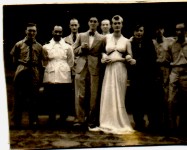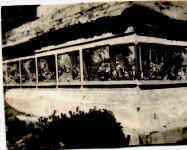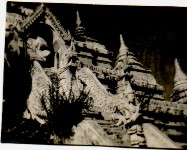We reported back to the camp and were told that we were going to a camp on the side of the Great Bitter Lakes which are a part of the Suez Canal. We had no aircraft and to all intents and purposes it was like a holiday camp, there was swimming and boating, no drill or parades. Then they told us that we were going to Singapore and were waiting for a ship. Finally we moved down to Suez and boarded the Felix Russell, a free French passenger and freight ship.
We were put down in the forward hold which had been converted into sleeping accommodation and had tables fixed on the decks beside the cabins. There was one routine we quickly got into. As commonly happens on ships, weevils had got into the flour, so when we got our bread we used to hold it up to the light and pick out all the black specks before eating it.
We sailed down the Red Sea and put into the port of Mogadishu in what was then Italian Somaliland to pick up Italian prisoners from the Ethiopian campaign. When the army brought the Italian officers on board they asked where the cabins were. The Captain, a free Frenchman, said that no Italians were going to travel in cabins on his ship. They could go down into the hold and the RAF would have the cabins, or he wouldn’t be sailing. So we all moved into the luxury of the cabins.
 |
| Review |
A number of the prisoners were Blackshirts and they were extremely arrogant. One of them stopped beside us and said,’You have lost the war.’ We replied, ‘What are you doing here then?’ They wouldn’t believe that we had been holding our own in the desert.
As we were once again on a ship with time on our hands we put on our second show. We called it the ‘Russell Revue’ and roped in a Pilot Officer to play the female lead (Sid Hind who usually played this part had decided to give this show a miss). We didn’t have a pianist so someone suggested that we look for one among the Italian prisoners. We obtained permission to do this, and found Sub. Lt. Cortoni who turned out to be excellent, so we got him to play a few numbers. The show was reasonable and I think everyone enjoyed it, but it hadn’t got the swing of our first show.
It was now the middle of January 1942 and I think we arrived at Bombay about the end of the month. We came straight off the boat on to a troop train, a proper one with wooden seats and kind of hammocks to sleep in. These had been used for years by the army in India. We started out across India to Calcutta, which took about 15 days. Apparently we had no priority and had to wait in sidings while the passenger trains went through. In fact we were extremely lucky, because while we were on the train, Singapore was being attacked by the Japanese. If we hadn’t taken so long we might have been there at this time.
In Calcutta we were billeted in a barracks which was the South Staffordshire Regiment’s base. That really shook us; the South Staffs were still under peacetime routine out there and they used to have regular kit inspections. However, a kit inspection consisted of getting their bearer to lay out all their kit and stand beside it while they dressed up in whites and went out into town. They had never seen any fighting at all and didn’t know the first thing about it. We were there about three weeks or so.
In the desert, we had given up our RAF khaki drill uniform and were fitted out with army-type battle dress with red RAF flashes on the sleeves. Everyone in Calcutta thought we were paratroops, so we didn’t disillusion them.
Eventually we were taken down to the docks and put on to a coastal steamer. The South Staffs came with us. One of the things we had learnt was when you put a tin hat on, you didn’t put the strap under your chin. If you did and a shell or bomb burst near you, it could break your neck, so our straps used to go round the back of our heads. The South Staffs looked at us and said, ‘What are you wearing them like that for?’ We told them and they all copied us.
The steamer we were on had metal doors with slits in them at the top of the steps going up to the bridge, and big curved sets of spikes out of the side of the bridge. We were curious about these and the crews told us that these waters had a lot of Chinese pirates. The method they used was to put a number of coolies as passengers on the ships and when the pirate ship appeared, the coolies would rush the bridge and take over the ship. The spikes, metal doors and guns which they had on the bridge was their defence against attack. On one occasion the coolies were frustrated and set fire to the ship beneath the bridge. The captain turned the ship round so that the flames blew back toward the coolies and they all had to jump overboard into what were possibly shark infested waters.
It took us about five days to get to Rangoon which was about two miles up the Irrawaddy River. Now the river was very narrow and a ship could not turn round, so either it had to go up or come down backwards. We went up backwards which was a very slow journey and we were scared all the time the the Japs would come over and bomb us.
The docks in Rangoon were loaded with all manner of stores and vehicles. I understand that eventually it was not found possible to get all these stores to the troops so they were pushed over the side into the river.
We disembarked and they took us to the zoo where we were billeted for the night. I say billeted - in fact we slept beside the paths. The owner of the zoo said that he had shot most of the dangerous animals and offered me a tiger skin - what on earth I was going to do with it? I don’t know. Anyway, I refused the offer.
That night the Japs came over and bombed Rangoon. Now, there was a huge gorilla in a big bell-like cage just near us and when the bombing started he climbed to the top of the cage screaming and shaking the cage which rocked backwards and forwards. We were more frightened of him than the bombers.
The next morning they marched us off to the railway station where we boarded a train and moved off north toward Mandalay. Then we discovered that there were no rations for us and we were told not to drink the water because of cholera. I managed to buy a huge bunch of bananas (about 70). I can tell you that although they fill you up, you don’t feel as though you have eaten anything. We used to go down to the engine and draw off some hot water, which we drank when it cooled.
We were on that train five days. We stopped for a while at Taundywindy to change engines and as we were going to be there several hours, I went off into the jungle and discovered a beautiful pagoda with a frieze of the life of Buddha with steps leading to the top guarded by the Chindit statues. I took some photos of it which I have in my album.
 |
| Buddha |
I carried a small Zeiss pocket camera with me the whole time I was abroad. I can’t remember where I got the film nor the chemicals because I did all my own developing and printing. I do know that I was never without a film. The hot weather at times played havoc with the developing, but the huts in the jungle were very dark late at night so I never needed a darkroom. In fact sometimes I could view the progress of my developing by the light of the fireflies which were everywhere.
We carried on up to Magwe which was a normal aerodrome and were surprised to find that they had just built a new hangar, big enough for at least three of our planes. It was made of solid teak. Mind you, the jungles all around there were of teak, and it does not get eaten by white ants, so I suppose it made sense. When they first sent Hurricanes out to the Far East they had wooden propellors, and a day or two after arriving the propellors fell to pieces when they started up the engines. The white ants (termites) had eaten them all.
 |
| Pagoda |
We never got the opportunity to use the hangar because the Japs were coming up through Burma and the drome was being flooded by civilians who wanted to be evacuated. There were a lot of British expatriates in Burma who were working on the oil wells and in the ruby mines. They had been warned to leave the country, but a lot of them ignored this advice and were now clogging the roads to get away from the South. It was decided to get as many as possible out, so we never did any operations but concentrated on operating and servicing all types of aircraft which were sent to us.
China had been fighting the Japanese long before they attacked America, and quite a number of Americans had bought their own planes and were, I suppose, what we would now call mercenaries. They were known as the Flying Tigers and were paid by the Chinese Government for every Japanese plane they shot down. I’m not certain how these kills were verified but the pilots seemed to be quite happy with the system. Being freelance, they would land at any drome without asking for permission and would buy petrol for their planes wherever possible. They often landed at Magwe and if they were forced to spend the night there, would taxi their planes down the main road away from the drome, in case of air raids.
We were operating mainly DC2’s to evacuate the civilians and there was little in the way of flight control on the airfield. One of our planes was running up its engines to test them and a great cloud of dust was blowing across the runway. A DC2 had just been loaded up and was taking off, when we saw a Flying Tiger coming in to land in the opposite direction. Because of the dust neither pilot could see each other and we watched in horror as the DC2 entered the dust cloud. The fighter plane reached the cloud just as the DC2 emerged - it was in the air just scraping over the top of the fighter.
The civilians were desperate to get away, some offering large sums of money to try to jump the queues. I did hear that some mothers offered themselves to the aircrews if they would save their children, but I don’t know how true that was. All I saw was an attempt at a fairly orderly evacuation.
Finally, it was decided that the squadrons were to be evacuated and the civilians were told that they would have to go up toward the Burma road in the hope that they could be evacuated from aerodromes up there. If not, then they would have to take the Burma road into China.
We were told to remove the bolts from our rifles and throw the rifles and bolts into the river Irrawaddy. We were only allowed our personal gear, so I was unable to bring the radio from Wally out with me. I expect it was eventually captured by the Japs and I wonder if whoever got it realised that it was probably an antique and quite valuable. We were put on DC2’s and flown over the mountains to Akyab. It was a hair-raising journey with the plane dropping a hundred feet or so every time it flew into airpockets. The mountain tops would rush up towards us and you wondered whether you were going to hit them.
At Akyab we were billeted in a hangar. Some of the chaps wrapped themselves up in their greatcoats to try to avoid the mosquitoes ,but four of us got together in the corner of the hangar and were talking when the Adjutant came in. He saw us and told us to get on a truck outside the hangar. He wouldn’t tell us where we were going but the truck drove down to the docks and we were told to board a ship which was full of refugees.





